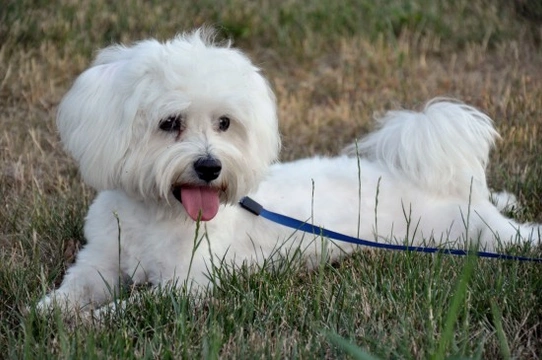
Maltese dog hereditary health and health testing
The Maltese dog is a small breed that belongs with the toy dog group, and is a descendant of dogs that originated from the Central Mediterranean Area, with the breed’s name coming from the island of Malta. The breed is distinctive for its long, silky coat that is single layered, and should be straight and not curly or wavy. The Maltese is one of the various little white dog breeds that make for popular lapdogs and companions, and their coats should be pure white, although a slight ivory tint is permissible on the ears.
They are classed as a non-shedding breed, which makes the dog an option worth considering for people who are prone to allergies to dogs, but also means that the coats require a reasonable amount of maintenance. The Maltese can also be trimmed and clipped into a shorter coat pattern in order to make the coat easier to care for, and the most common cut used is called the “puppy cut,” which consists of trimming the entire body to a uniform length all over, usually around 1”.
If you are looking into dog ownership and the Maltese dog is a breed that appeals to you, it is of course important to find out as much as possible about the breed before committing to a purchase, and this includes finding out about the general health and average lifespan of the breed. In this article, we will look at the hereditary health and longevity of the Maltese dog in more detail. Read on to learn more.
Maltese dog longevity
The average lifespan of the Maltese dog is 12-15 years, which provides quite a range of variance in terms of the average. Towards the lower end of the scale is firmly in the middle of the rankings across the board for all breeds of a similar size, while the top end indicates a longer lifespan on average than most other breeds.
Genetic diversity
The coefficient of inbreeding statistic for the Maltese dog is 5.5%, which is within the acceptable range for pedigree dogs, which should be 6.25% or lower. This indicates that the Maltese dog is not subjected to a significant degree of inbreeding, but breeders should nevertheless seek to reduce the coefficient of inbreeding statistic within their own breed lines where possible.
Conformation issues
The general shape and build of the Maltese dog is considered to be fit for life, and does not place the breed at risk of any particular health problems due to their shape and conformation.
However, the long coat that does not shed requires a reasonable amount of attention, as it can soon become tangled and pick up dirt and debris. The hair over the eyes should be trimmed in order to allow for normal vision.
Health testing for the Maltese dog
Generally, the Maltese dog is considered to be a robust and healthy little dog that is not considered to be at high risk of inheriting a wide range of health problems and defects. However, the British Veterinary Association and The Kennel Club recommend health screening for a condition called chiari malformation syringomyelia, which is a neurological condition that leads to the development of fluid pockets on the spinal cord, which can be very painful and disabling in severe cases.
Other health issues
While chiari malformation syringomyelia is the only condition for which health screening is advised within Maltese breed pools, like all dog breeds, the Maltese may potentially be affected by a range of other health issues too. Some of these have a hereditary or genetic element to them, but they do not present within the breed with a high enough rate of occurrence that pre-breeding health screening is advised.
Some of the known health conditions that may potentially affect dogs of the breed include:
- Acquired tremor syndrome, a condition that causes tremors of the body within young adult dogs, the reasons for which are unknown.
- Necrotising meningoencephalitis, an autoimmune disorder that leads to inflammation of the brain in young dogs, which is often fatal.
- Myxomatous degeneration of the mitral valve of the heart, a type of heart disease that can lead to heart failure.
- Patent ductus arteriosus, another type of heart disease caused by the failure of the aortic-pulmonary duct to close properly after birth, leading to gradual heart failure.
- Pyloric stenosis, a condition caused by an overly narrow entrance to the stomach, which means that only liquid food can be tolerated and other foods will be vomited back up.
- Portosystemic shunt, a blood disorder caused by the circulatory system bypassing the liver, leading to a build-up of toxins within the blood.
- Cataracts of the eyes.
- Entropion of the eyelids.
- Hydrocephalus, or fluid on the brain.
- Patellar luxation of the kneecaps.
- Hereditary deafness.
- Hypothyroidism, which can generally be managed with medication.



